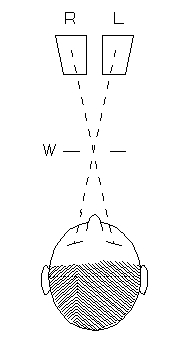
Shifty methods for taking stereo 3-d pictures.
by Donald E. Simanek.
The stereo pictures below are presented for cross-eye free viewing. You should have a display screen at least 1000 pixels wide. The cross-eyed viewing method takes some people a while to learn, but is worth the effort, for stereo pairs may be presented on the page (or screen) much larger than with other free-viewing methods. To learn how to do this, see How to View 3d. At first, it helps to move your head farther from the screen until you can reliably fuse the two pictures, then move closer, slowly.
The cha-cha method.
You can have fun taking stereo pictures without investing in a stereo camera. The basic principle of stereo 3-d is that you need two pictures of the same scene from slightly different points of view. My first stereos were made with a Kodak Box Brownie camera by taking one picture, advancing the film then moving the camera to a position displaced by 2.5 inches and taking the other picture. When the pictures were developed, I mounted them for viewing in a Holmes stereoscope.This method isn't good if there's anything moving in the scene: people, animals, or wind-blown foliage. Some people can hold a pose long enough to have their portraits made by this method.
Thanks to modern software for stereo, such as StereoPhotoMaker, you can usually get by with hand-held stereos. Just be sure to avoid toe-in of the camera axis in the two positions. Keep the camera pointed to the same point on the horizon, and avoid rotating the camera about that axis. However, even rotation and size disparities can usually be corrected with StereoPhotoMaker.
If you happen not to have your stereo camera with you, why not try a digital cha-cha stereo anyway? If it works out, you'll have a nice stereo picture, if not, you'll still have the picture in 2-d and won't have lost much time nor money.
Here's a pleasant scene at Shaw's Gardens (The Missouri Botanical Garden) in St. Louis, MO. Hand-held digital picture taken in 2005.

This landscaped waterfall and stream was photographed in 2007 at Meijer Gardens in Grand Rapids, Michigan. The stereo shift was a bit larger than normal, so the picture is "hyperstereo", and therefore appears smaller than reality. Usually moving water can cause problems in such pictures, but here I think it actually adds to the illusion of motion of the water. Also, this is one of those rare situations where, I think, a wide format stereo picture suits the subject.

Also at Meijer Gardens is a sculpture tribute to Leonardo da Vinci, a horse inspired by the one Leonardo planed to cast, but never did. This statue is 12 feet high at its back, on a flat plaza rather far from anything else. But thanks to the magic of photography, we can make it appear that he's taken off on a stroll to explore the other parts of this landscaped garden. I did some serious retouching to remove distracting barriers around some construction on the far grassy slope. July 2009.
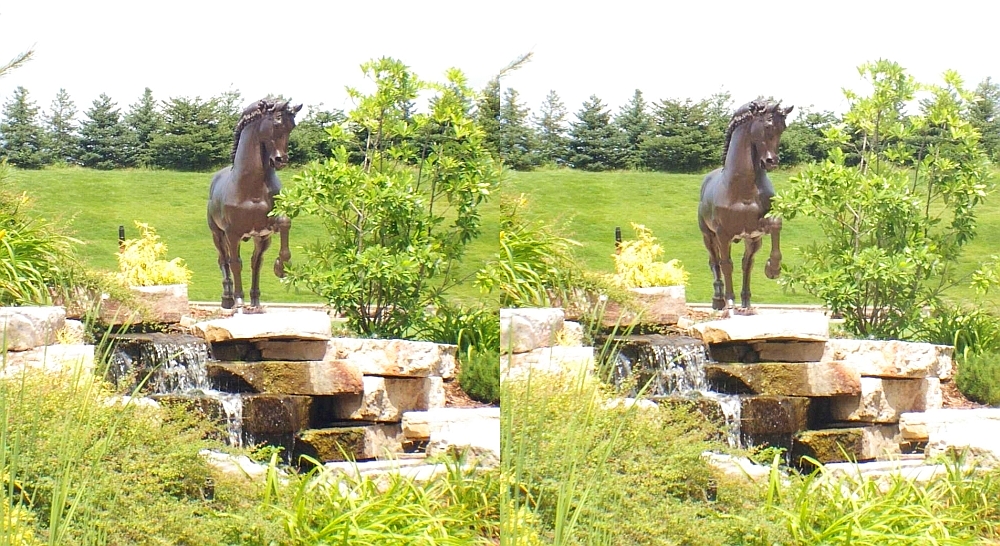
The next picture shows the horse in its own plaza. Note the clouds. Their appearance is confusing. They moved horizontally significantly in the short time interval between taking the left and right pictures, so they appear to be closer than the horse. If the pictures had been taken in the reverse order, they would have seemed more distant than the distant grassy knoll. This can be a pitfall for the photographer, or an opportunity for an interesting effect. When taking such cha-cha pairs outdoors note the direction of cloud movement, and shift the camera in the direction they are moving. But if the clouds have significant up or down movement, your chances of a good result are very poor.

This picture, looking West across the Mississippi toward Davenport, Iowa, required no tinkering after it was shot. Taken spring, 2007 from the Illinois welcome center. Cars and trucks on the highway just won't stand still for this kind of hand held stereoscopy.

And just a short walk across the road was this calm pond. This picture was obviously taken in a different season, though.
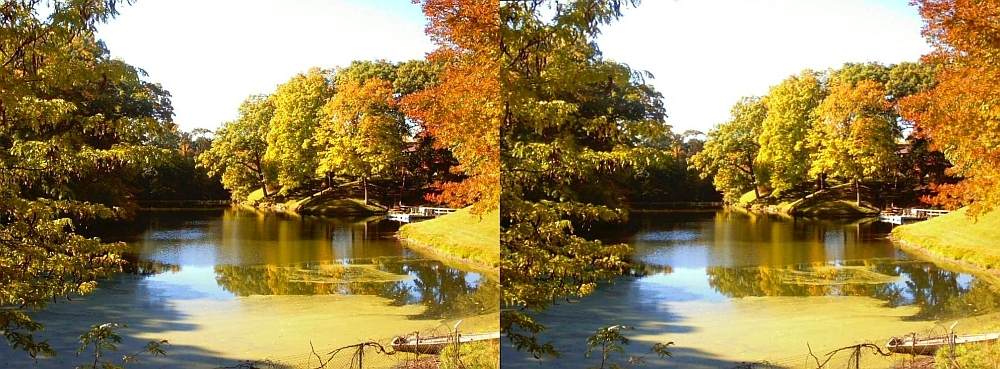
Fall in Pennsylvania can, if it's a good year like 1996, provide some very pleasing pictures. This scene was at Bald Eagle State Park.

Close ups of leaves are especially nice in stereo, for the individual leaves stand out better. This was taken in Western Pennsylvania in mid-October, after most other treas had dropped their leaves.

This picture is of rather elaborate Christmas lighting, taken in December 2007. The neighbors had fully competitive displays also.

A fern on the forest floor. Taken with a digital camera hand-held.

The "Pilatushaus" in Oberammergau. The wall paintings, being called "Lüftlmalerei" here (i.e. "free air paintings") were made by Franz Seraph Zwinck in 1784. It shows the scene where Roman governor Pilatus speaks his condemnation of Jesus. The Pilatushaus currently houses craftsmen who do traditional work in their chambers. It is called the "living workshop". It is also the location of the marriage license bureau. I used too large a shift here, so the depth is exaggerated. Also I had to retouch out a person who walked into the scene.

The nice thing about sculptures is that they don't move while you take their picture. These street musicians are in downtown Holland, Michigan. July 2009.

Close-up stereo.
Museums and zoos generally don't allow tripods and flash. And some displays are rather dimly lighted. Then there's the problem of other people being in the way of good shots. But sometimes you get lucky. The next two pictues were made with a digital camera, hand held, moving the camera sidewise about 1 inch between shots. The first picture is a tropical tree frog. The second is Cratophyrus Ornatus (Ornate Horned Frog). Time the shots with the frog's breathing. Taken Feb. 2008 at Clyde Peeling's Reptileland, near Allenwood, PA.The 1/30 rule is often recommended for choosing the appropriate camera shift for good depth. If the nearest object in the scene is distance D away, then the camera axis shift should be D/30. Stereo cameras had their lens axes about 2.5 inches apart, so objects closer than 30 x 2.5 = 75 inches away are too close for comfortable viewing. I used about 1 inch shift for the next two pictures, at a distance of about 30 inches from the frogs.


The freedom to choose the amount of shift can be useful. This iris picture was taken in a public park, hand held, with an interaxial a bit larger than is usually considered ideal. Yet the enhanced depth is interesting when seen in cross-view. It seems extreme when the pairs arranged in left-right order for parallel viewing. Of course shift stereo of nearby objects isn't practical if there is a breeze, or if the subject is a small animal or insect.
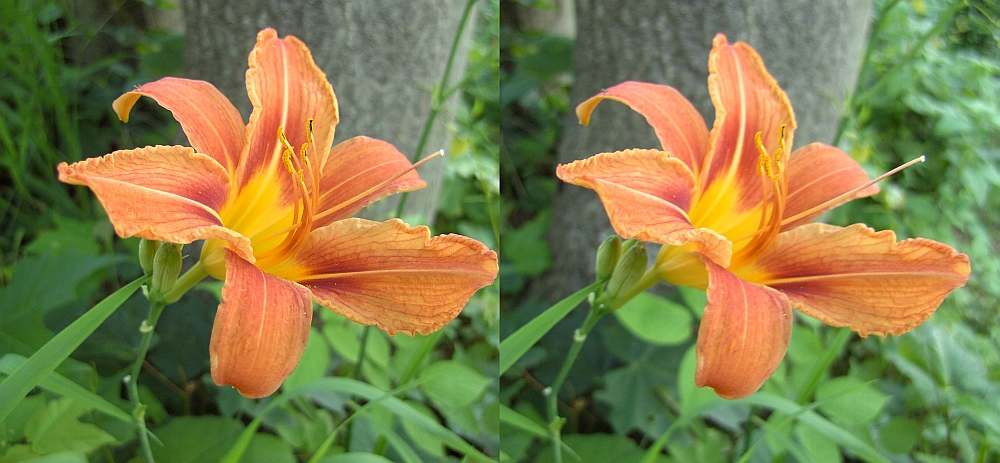
Hyperstereo.
Large-baseline stereo is called hyperstereo. It can bring out stereo relief in distance scenes that would otherwise appear "flat". The price you pay is that the scene will appear "miniaturized", smaller than normal. A hyperstereo of a distant scene can appear like a miniature model for a model train layout. The 1/30 rule is again a good guide.This picture, looking down on Salzburg, Austria, had an axial separation of about 10 feet, obtained by taking one picture, walking to a location 10 feet away, framing the scene identically and taking the second picture. Sometimes you get a usable picture.


One must avoid including nearby objects in a hyperstereo picture. The bush at the right of this picture seems almost too close in stereo. The castle walls show depth, but the distant town seems too flat. The axial separation ought to have been larger, as in the previous picture.
Here's a first attempt at a two-camera wide interocular setup. Two Kodak Pony cameras were mounted at the ends of a 6 foot long aluminum bar, which in turn was on a tripod. A pneumatic system triggered both shutters for simultaneous time exposure. Clearly the tripod and bar were not perfectly stable, and appeared to be vibrating. Oh, well. Next time. It also seems that one of the lenses wasn't as sharply focused, but with 3d the brain easily compensates for this.
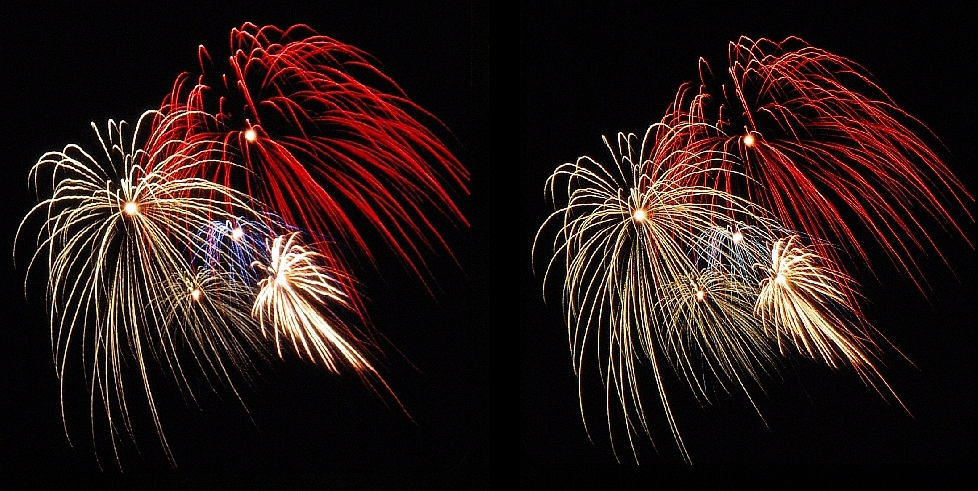
Hyperstereo from the air.
Handheld stereo from an airplane, near Albuquerque in 2004 with digital camera. The plane does the moving for you, so you must take two pictures in quick succession, framing them the same. It is important to aim the camera perpendicular to the plane's motion, and use a portion of the window that has the least distortion.
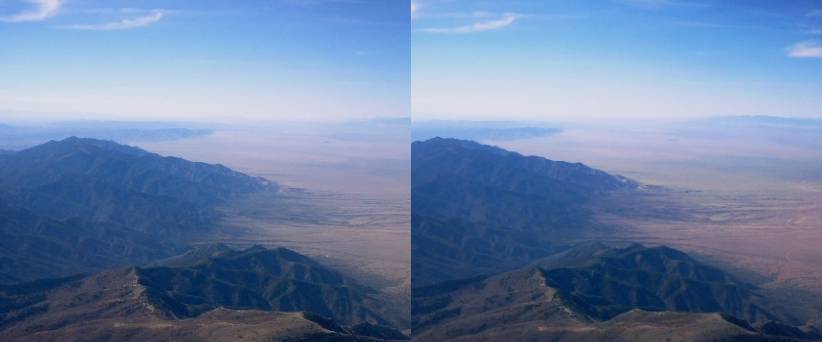
Clouds taken from an airplane. The parallax is a bit too large. I should have taken the second exposure more quickly.
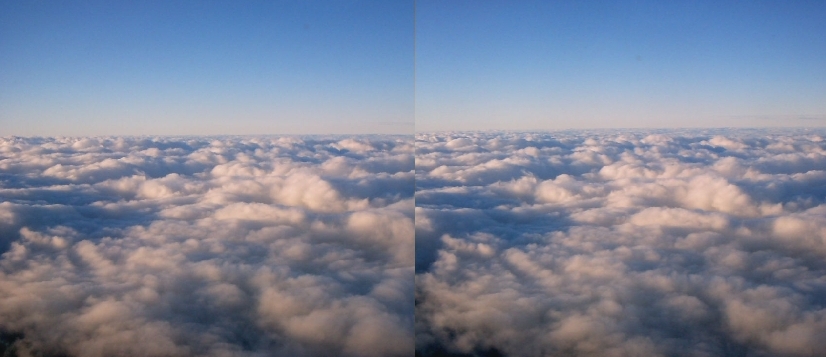
Above the clouds.
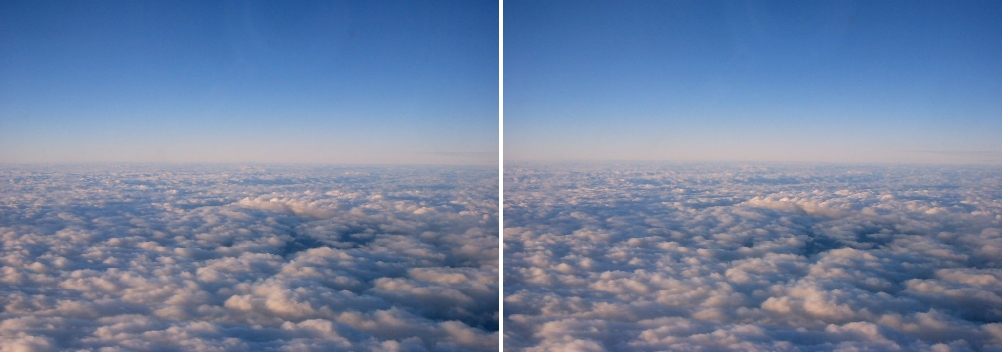
The slide-bar.
If you have the time, you can make shifty stereos with a slide-bar on a tripod. This is a device to shift the camera any desired amount, precisely. It's easy to make one yourself, and for close up work it is highly recommended, to maintain axial alignment and to avoid size differences in the pictures.
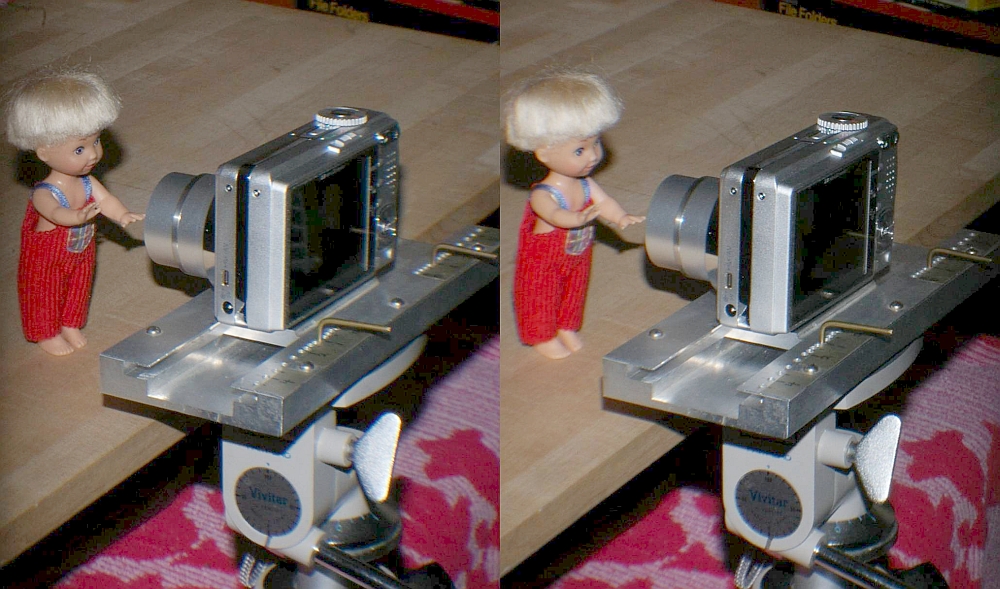
This homebuilt milled aluminum slide-bar has holes for brass pegs to preset the desired amount of shift, so that it can be done quickly and reliably.
All pictures on this page are © 2008 by Donald E. Simanek.
Stereos for cross-eyed viewing in 3d Gallery One.
Still more, mostly taken with a digital camera in 3d Gallery Two.
Stereo view cards in 3d Gallery Three.
The Loreo stereo attachment—improved 3d Gallery Five C.
The Loreo LIAC attachment as a 3d macro device, 3d Gallery Five D.
Home-built close-up stereo camera, 3d Gallery Four.
Review of the Loreo macro adapter, 3d Gallery Five B
Wildlife photography in your backyard, 3d Gallery Six.
A home-built digital stereo camera using mirrors 3d Gallery Seven.
Stereo close-up photography in your garden 3d Gallery Eight.
Stereo photography in your aquarium 3d Gallery Nine.
Stereo digital infrared photography 3d Gallery Ten.
Wider angle stereo with the Loreo LIAC 3d Gallery ll. A failed experiment.
Review of the Fuji FinePix Real 3D W1 camera 3d Gallery 12.
Macrophotography with the Fuji 3D camera. 3d Gallery13.
Panoramic stereo photography. 3d Gallery 14.
Tips for stereo photography with the Fuji 3d camera. 3d Gallery 15.
Mirror methods for stereo photography. 3d gallery 16.
The Fuji 3d macro adapter using mirrors, by Paul Turvill.
The Fuji 3d macro adapter with flash! 3d gallery 17.
Critters in stereo. 3d gallery 18
Wide angle stereo. 3d gallery 19.
Telephoto Stereo. 3d gallery 20.
2D to 3d Conversion. 3d gallery 21.
Stereos from outer space. 3d gallery 22.
Digital stereo photography tricks and effects.
Shifty methods for taking stereo pictures.
Stereoscopy with two synchronized cameras by Mike Andrus.
Guidelines for Stereo Composition.
Return to the the 3d and illusions page.
Return to Donald Simanek's front page.
—Donald E. Simanek